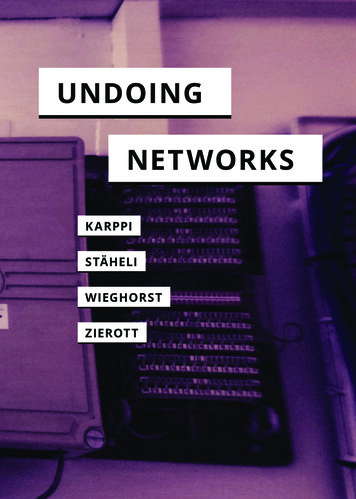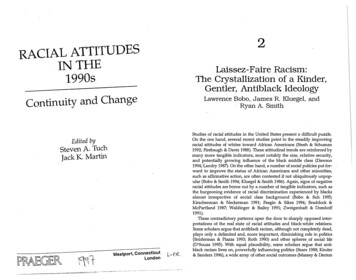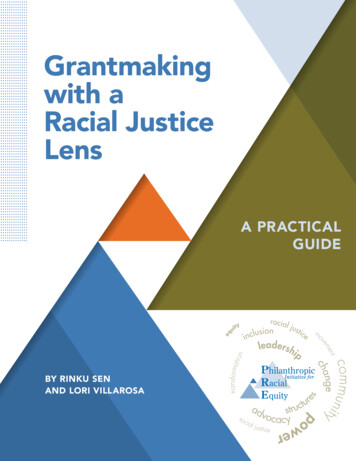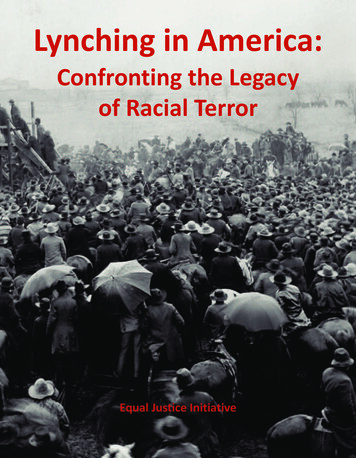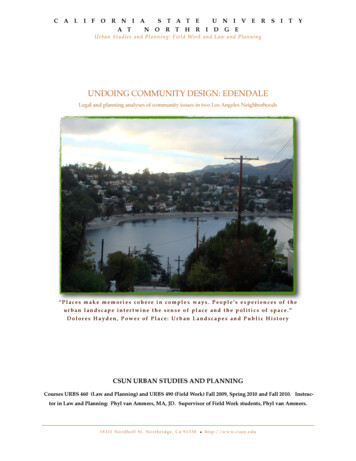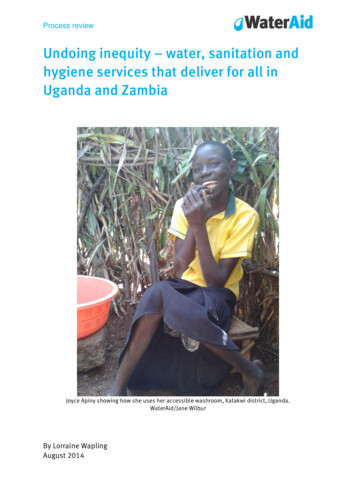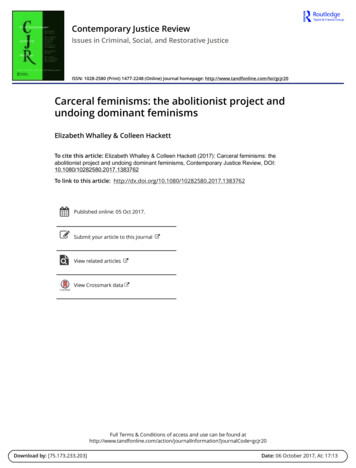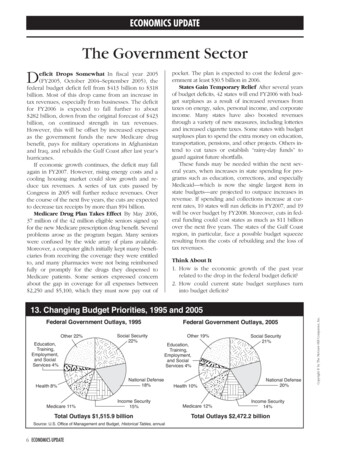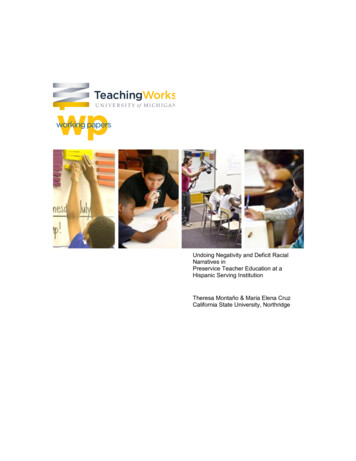
Transcription
Undoing Negativity and Deficit RacialNarratives inPreservice Teacher Education at aHispanic Serving InstitutionTheresa Montaño & Maria Elena CruzCalifornia State University, Northridge
TeachingWorks working papers are unpublished manuscripts that focus on the professionaltraining of teachers. They involve analysis of data or literature and reflect “good thinking” – clear,systematic interrogation of issues critical in the field of teacher training.These working papers are circulated to promote discussion. As such they are freely available toa broad audience interested in the study and improvement of ideas and practices in teachereducation.TeachingWorks working papers are subject to a blind review process that focuses on therelevance of the proposed work to pressing problems in teacher education, the transparency andrelevance of the methods to the questions asked, as well as the quality of the writing. Allsubmissions should be original.The views expressed herein are those of the authors and do not necessarily reflect theviews of the University of Michigan and/or TeachingWorks.2TeachingWorks working papersMontaño & Cruz, May 2018
Undoing Negativity and Deficit Racial Narratives in Preservice Teacher Education at a HispanicServing InstitutionTheresa Montaño & Maria Elena CruzCalifornia State University NorthridgeDr. Theresa Montaño is the Vice President of the California Teachers Association and aprofessor of Chicana/o Studies at California State University, Northridge. Montaño’s commitmentto social justice and to broadening access to higher education inform her research interests. Priorto entering the field of higher education, Theresa was a Social Studies teacher in Los Angelesand worked at United Teachers Los Angeles (UTLA). Her research, publications andpresentations focus mainly on issues like Chicana/o-Latino/a educational equity; criticalmulticultural multilingual education; and, teacher activism. She has published several articles andco-edited Assault on Kids: How Hyperaccountability, Corporatization and Deficit Ideologies areDestroying Our Schools with Roberta Ahlquist and Paul Gorski. Her latest book project isTransforming Practices in Urban Education with William DeLaTorre and Jacqueline Hughes.Dr. Maria Elena Cruz is a Lecturer in Chicana/o Studies at California State University, Northridge(CSUN) focused on preparing students entering teaching professions through the “It Takes aBarrio” (ITaB) Project. She has devoted her professional life working at the grassroots level withlow-income Latinx/Chicanx students and their parents in making the leap from high school tohigher education. She is Director of Upward Bound Oxnard, a pre-college federal TRIO programdesigned to prepare and motivate students for success in education beyond secondary school.She has published articles on Latinx/Chicanx teacher preparation and mother-daughtercommunication about sexual and reproductive health.3TeachingWorks working papersMontaño & Cruz, May 2018
AbstractThe quest to prepare teachers for culturally and linguistically diverse schools is the focus of thispaper. We describe what we do in one Chicana/o Studies course required for students seeking ateaching credential in the state of California. A Chicana/o Studies Informed Activist pedagogicalmodel is used to enable preservice teachers to undo and challenge deficit racial narratives thatsome educators have of Latinx/Chicanx students. We focus on the high leverage teachingpractices of a K-12 Latina Teachers Support Group using participatory classroom events andperformance activities. We solicited lesson plans and pedagogical practices used by theseteachers to demonstrate to our preservice teachers the powerful ways practitioners facilitate theproductive capacities of their students to learn, while simultaneously infusing Chicana/o Studies,funds of knowledge, community cultural wealth and ventajas y conocimientos into the classroom.4TeachingWorks working papersMontaño & Cruz, May 2018
UNDOING NEGATIVITY AND DEFICIT RACIAL NARRATIVES IN PRESERVICE TEACHEREDUCATION AT A HISPANIC SERVING INSTITUTIONThe year 2018 will be the 50th anniversary of the Chicano/a Student Walkouts. On March1, 1968, more than 15,000 high school students walked out of several Los Angeles high schoolscalling for an end to the inferior quality of education Mexican American students were receiving.The students and community protested for one week, packing school board meetings, holdingrallies and shutting down several high schools. Student activists developed a list of demandsincluding the demand that the history and culture of Mexican Americans be recognized andbecome a viable part of the curriculum. Soon after, school districts and colleges began to designethnic studies programs. Given the dearth of curricular materials on the subject, teachers andfaculty engaged in a desperate effort to design lesson plans, secure texts, and implementMexican-American Studies in schools and colleges throughout the Southwestern United States.Students, K-12 public education teachers, and university faculty were critical partners in thedevelopment of the first courses in Chicana and Chicano Studies. On college campuses, Chicanaand Chicano Studies became part of the larger sociopolitical movement that would facilitate thetransformation of teacher education programs to reflect a broader multicultural, multiethnic,multilingual, and critical curriculum. As a consequence of the struggle, Chicano and ChicanaStudies and other Ethnic Studies programs became vital components of many teacherpreparation programs. In truth, however, the battle to establish a presence for Chicana andChicano/Raza1 Studies in public schools and colleges were only partially successful.Recent battles2 in Arizona, California, and Texas are stark reminders that 50 years later,we are still engaged in a struggle to adopt Ethnic Studies as a course requirement for graduationfrom high school. Even though research proves that Ethnic Studies boosts student attendance,increases student’s grade point average, and improves academic achievement (Altschul,Oyserman & Bybee, 2006; 2008; Wentworth, Carranza & Stipek, 2016) the struggle to legitimizeEthnic Studies persists. The purpose of this paper is not to debate the question of Ethnic Studiesas a curricular or educational justice matter, but to postulate that, as a content area, it canengage the most disengaged students in the productive process of learning.We teach at 4-year comprehensive state university in Southern California. Ourundergraduate program in teacher education is situated in the department of Chicana andChicano Studies at a Hispanic-Serving Institution. Our goal includes preparing future educators toteach Chicanx and Latinx students who comprise the majority of the student population of ourstate. To that end, we use a Chicana/o Studies Informed Activist pedagogical model to enable ourpreservice teachers to undo the deficit racial narratives that some educators have ofChicanx/Latinx students. We use this opportunity to describe what we do in one Chicana/oStudies course required by students seeking a teaching credential in the state of California. Wechallenge our preservice teachers to identify and undo the deficit racial narratives prevalent in ourclassrooms and our schools and to replace them by tapping and affirming the funds of knowledge(Moll, Amanti, Neff & Gonzalez, 1992) and community cultural wealth (Yosso, 2005) of Chicanxand Latinx students in urban communities of Southern California.1For the purpose of this paper, if we are speaking about those of Latin American (Latinx) or MexicanAmerican/Chicano(Chicanx) students in the current sociopolitical context, we will use the gender-inclusiveway. If we are describing historical issues, such as the walk-outs, the name of our department or the field ofstudy, we will use the term used at that time like Chicana/o or Chicana and Chicano.2In 2010, former Governor Jan Brewer signed HB2281 blocking schools from teaching ethnic studies inArizona. Seven years later, a federal judge found the ban unconstitutional (Depenbrock, 2017). In 2015,California Governor Jerry Brown vetoed ethnic studies bill AB 101 only to sign a more modest bill two yearslater (Planas, 2017). The efforts to secure ethnic studies as a graduation requirement continues inCalifornia. In 2018, The Texas Board of Education gave its final approval of ethnic studies classes afteryears of bitter debating on moving the classes forward (Swaby, 2018).5TeachingWorks working papersMontaño & Cruz, May 2018
Our PhilosophyWhile it is true that educators must connect the cultural, familial, historical, and linguistic(CFHL) knowledge of students inherent in their homes and social networks to teaching andlearning, schoolwide services must also be adapted to include this knowledge. Moreover,challenging deficit ideology and racial narratives cannot be done without connecting thisknowledge to improving the academic performance and knowledge that Latinx and Chicanxstudents need to navigate the educational pipeline, from pre-kindergarten to university.Herein lies the challenge. In our course, we ask our students to tap the CFHL knowledgeof Latinx/Chicanx communities and to infuse this knowledge into the production of culturallyresponsive lessons and/or schoolwide action projects. We ask them to design units, lesson plans,or projects which incorporate learning activities that promote biliteracy, multicultural history, andculturally relevant science or math activities. Sleeter (2016) argues that textbooks, history andliterature instructional materials, and statewide content standards continue to acknowledge thecontributions of white people at the expense of people of color. Our challenge is to graduateeducators who are equipped to infuse community cultural capital and the cultural and linguisticknowledge of Latinx and Chicanx students into their lessons and programs. Thus, if they knowvery little about the community, have never taken a Chicana or Chicano Studies class, or areinfluenced by deficit ideology, then a well-rounded, rigorous education for Latinx and Chicanxstudents will remain a dream deferred.The Relevance of Chicana/o StudiesAs the nation’s school-age population becomes increasingly diverse, Ethnic Studies hasbecome the rallying call for educational activists. In California, Assembly member Jose Medina, aformer Chicana/o Studies faculty member introduced AB 2772 that requires every studentgraduating from a California high school to take an Ethnic Studies course. Many large urbanschool districts, including El Rancho Unified School District, Los Angeles Unified School District,Montebello Unified School District, and San Francisco Unified School District, and others havealready required an Ethnic Studies course for graduation from high school. As we write thisarticle, teachers and educators are working diligently to draft curriculum for implementationthroughout the state of California. We deem that an important part of the Ethnic Studiescurriculum is for students to see themselves in literature and history textbooks. Recent studiessuggest academic benefits to ethnic studies courses (Dee & Penner, 2016). Also, we agree thatEthnic Studies should be a stand-alone graduation requirement across the United States. Thereare many disciplines integrated into the field of Ethnic Studies, namely Asian American Studies,Afrikana Studies, American Indian Studies and more. While we agree that the teaching of EthnicStudies is a critical element of a holistic education, in our case we focus on a Chicana/o Studies.For historical, cultural, demographic and political reasons, we maintain that in the SouthwestUnited States and California, very educator at every grade level must be able to infuse Chicana/oStudies into the standard curriculum.Our university houses the oldest and largest Chicana and Chicano Studies department inthe country. We happen to be faculty in this department and therefore, this paper uses thedefinition of Chicana/o Studies from the department located at our university. It is as follows:Chicana and Chicano Studies is an Area Studies field that advances a commonunderstanding of the Chicana/o and Latina/o experience in the United States. Coursesreflect a multidisciplinary approach to the understanding of Chicana/o histories, politics,culture, language and education (Chicana and Chicano Studies Website).Rodolfo Acuña, historian and founder of the department of Chicana and Chicano Studies,began by recruiting faculty who were knowledgeable of Chicana/o Studies as well as fields likehistory, politics, culture, language or education. Courses were initially designed to bringawareness to students of the Chicanx/Latinx experience and to offer a counter critique orperspective to the dominant narratives in traditional disciplines. In later years, the changingdemographics convinced members of the department that it was necessary to expand and6TeachingWorks working papersMontaño & Cruz, May 2018
prepare future educators to teach in schools that were predominately Chicanx/Latinx. TwoChicano/a Studies Teacher Preparation programs have been offered to meet this need.Chicano/a Studies Teacher PreparationEstablishing a presence for Chicana/o Studies in teacher preparation has not been easy.Dr. Rudy Acuña (2011) documents the battle to establish such a presence at the California StateUniversity Northridge. In the 1970’s, after years of struggle, the department established“Operation Chicano Teacher” and developed an undergraduate major for prospective elementaryschool and secondary Social Studies teachers.Today we are the largest Chicana/o Studies department in the nation and have severalcourses for undergraduate and graduate students entering the teaching profession. Many ofthese courses are aligned with the California Standards for the Teaching Profession, theCalifornia Teaching Performance Expectations, and the California Teachers of English LearnersProgram. Our courses are cross-listed with the academic programs for prospective teachersoffered by the College of Education including the elementary, secondary, and special educationcredential. Prospective teachers in other disciplines may also take our course to fulfill a courserequired for meeting the aforementioned standards.We teach Chicana/o Studies 417: Equity and Diversity in Schools. The course isdesigned to introduce students to the Chicana/o education experience and to prepare teachercandidates to educate this growing demographic. We embrace our obligation to teach ourstudents the historical and contemporary experiences of Chicano/as in education. With this inmind, we embarked upon our journey to “move our students beyond open-mindedness andtowards a critical understanding about what it means to be Chicano/a in today’s world. Part of thiscourse requires our students to complete service-learning hours in the “It Takes a Barrio” (ITaB)Project.The “It Takes a Barrio” (ITaB) ProjectThe ITaB project is a recursive pipeline into teaching. The project seeks to increase thenumbers of Chicana/o and Latina/o college students, both undergraduate and graduate, whochoose to enter the teaching profession. The program uses experiential learning strategies suchas academic service learning, service to the community, and designing and implementing ethnicstudies focused lesson plans. In field placements, the preservice teachers also collaborate withcredentialed teacher mentors while working with students in K-12 schools. Our students alsowork with parents, partner with local community colleges and nonprofit organizations, andbecome members of the Student California Teachers Association.The project is driven by a comprehensive view of student success premised on the beliefthat students require a diversity of opportunities to: learn culturally relevant content and theory;apply knowledge in real-life professional settings; give back to communities via service learning;engage in campus, community, and union activities that inform and promote a view of teaching asa meaningful and honorable profession; and involve parents and community members in thedevelopment of future teachers. (ITaB Project Evaluation Summary, 2016, p. 1).In 2017, the ITaB project grew to include a successfully designed, single-subjectcredential program for teachers wishing to teach social studies. An innovative bilingual programfor prospective bilingual elementary school teachers is currently under development. Our programis unique in that we recruit undergraduate students from different disciplines and graduatestudents from the Department of Chicana/o Studies.For many of our students our classes are the first courses they have ever taken inChicana/o Studies and for others who are Chicana/o Studies majors, it is not. As a department,we believe that curing Latinx/Chicanx students of “historical amnesia” is vital when tackling thenegativity associated with deficit thinking. As Rudy Acuña (1990) wrote, “a consequence ofhistorical amnesia is that it encourages the invention of a false reality, perpetuating the illusion ofsocial and political equality” (p.1). This perpetual illusion impedes the education Latinx andChicanx students deserve. Therefore, we use Chicana and Chicano Studies as a teaching tool forchallenging deficit views prevalent in our schools.7TeachingWorks working papersMontaño & Cruz, May 2018
Undoing Deficit Racial Narratives through ITaB and Chicana and Chicano StudiesA critical component of the work with our preservice teachers is to challenge deficit viewsand negative racial narratives present in our schools and in society. We explain in great detaillater in this paper our definition of deficit thinking and the process we used to “undo deficit racialnarrative” coupled with knowledge and some practice of high leverage teaching skills. In additionto the content of Chicana and Chicano Studies, we maintain that the affirmation of funds ofknowledge and community cultural wealth are critical for engaging Latinx/Chicanx students in thelearning process.In our effort to demonstrate to our prospective teachers what the components of Chicanaand Chicano Studies, funds of knowledge, and community cultural wealth look like in aclassroom, we asked members of a Latina Teacher Support (LTS) group to assist us in ourendeavors. We began by asking these practitioners to infuse these important components into astudent learning activity and to document the process so that we could “make it real” for ourpreservice teachers. We explained that their classroom practices would help our future teachersto see the abstract or theoretical concepts used in our course as possible and doable. In thiscase, we focused on the TeachingWorks high-leverage practice of specifying and reinforcingstudent behavior through literacy development by using three important components of our work:Chicana and Chicano Studies, funds of knowledge (Moll, Amanti, Neff & Gonzalez, 1992) andcommunity cultural wealth (Yosso, 2005) For the remainder of this essay, we will combine thethree elements into two: Chicana/o Studies and ventajas y conocimientos. We will describe ingreater detail later an explanation for our choice.We combined the realistic demonstration provided by the LTS Group and incorporatedthem into the activities that we use with our preservice teachers to undo racial negatives,challenge deficit racial narratives, and reproduce high-leverage teaching practices.It Takes a Barrio (ITaB): Our Extensive Community of PracticeLatina Teacher Support GroupTable IIn an effort to connect ourtheoretical models, participatory classroomevents, and performance activities to actualpractice, we focus on the high leverageteaching practices of Latinx/Chicanxclassroom teachers from various cities inCalifornia. These educators teach indistricts where the majority of students areChicanx/Latinx students. Two of theteachers teach in dual-immersion programs,two are elementary teachers, two aresecondary teachers, and one is a part-timeinstructor at a local university.Las mbresDia De%Los%MuertosFresno,%CAJoelitas eWe solicited lesson plans and pedagogical practices used by these teachers todemonstrate to our preservice teachers the powerful ways that practitioners facilitate theproductive capacities of their students to learn, while simultaneously infusing Chicana/o Studiesand ventajas y conocimientos into the classroom.Since our work advocates infusing CFHL knowledge inside and outside of classroomsand schools, we also present our students with schoolwide, community, and university models,such as It Takes a Barrio (teacher pipeline project), Student CTA (Student California TeachersAssociation), League of United Latin American Citizens (LULAC) Collegiate, Ethnic Studies NowVentura County, and other social projects our department or the teachers union is engaged with,8TeachingWorks working papersMontaño & Cruz, May 2018
including but not limited to the California Teachers Association California Reads, the National Dayof Action on Gun Violence, and Immigrant Rights Demonstrations.A View into the ClassroomWe began this semester by asking our mentees in the Latina Teacher Support group todescribe how they engaged the most disengaged of students in the active process of learning.We specifically asked them to select a single learning activity where their students’ funds ofknowledge and/or the community cultural capital were incorporated into the process of lessondevelopment and the student learning activity. We asked them to use Ethnic or Chicanx/LatinxStudies as the content area. We asked them to consider how they turned a disengaged studentinto an active and engaged learner, a disinterested student into a full participant, or a strugglingstudent into an exemplary student. We explained to the LTS group that we were looking forpedagogical practices that we could present to our preservice university students as examples ofhow teachers can use cultural, linguistic, historical or familial knowledge, community culturalcapital, and Chicanx/Ethnic Studies to promote productive, active learning and undo deficit racialnarratives of Latinx/Chicanx students.Table 2All of our teachers selected literacydevelopment in the target language(English) as the teaching practice. Eachteacher highlighted a different mode oflanguage development: listening,speaking, reading and writing; but allmodes were infused into the lesson.The teachers recorded the learningprocess in the classroom. We analyze thedata and documented the high leveragelearning activities associated with the lessons.We used the work of the LTS group asmodels to engage our preservice teachers inthe development of their course activities andprojects.The information noted in Table 2 arethe K-12 student learning outcomesemanating from the LTS lessons.The ContextLatinx and Chicanx StudentsAs Latinx and Chicanx students make up the majority of the student population inCalifornia, it would be impossible to grow the economy of the state without focusing on theeducational outcomes of these students. According to Education Trust West (2016), unless “weaccelerate the pace of change, our state is sending a disturbing message about the contributions,worth, and potential of Latino students” (p.8). Latinx/Chicanx students continue to attendsegregated schools, navigate an educational system that denies them access to coursework incollege prep, and are often considered less capable students than their counterparts (EducationTrust West, 2016). Moreover, according to the same source, Latinx/Chicanx students feel lessconnected to their schools. Given these stark realities, how are Latinx and Chicanx studentsexpected to engage in the productive learning process necessary to succeed in schools? Chicanxand Latinx children and youth are conscious of their incongruity within the educational system.They are astute listeners and cognizant of the deficit ideologies inherent in an educationalinstitution that denies them a legitimate space in history books, suppresses their language, andconsiders them less capable of learning.9TeachingWorks working papersMontaño & Cruz, May 2018
Let us be clear. The inability of Latinx/Chicanx students to succeed in school is not aboutculture, language, or socioeconomic status. It is not because Chicanx/Latinx students are poor ordo not speak fluent English or because Latinx/Chicanx parents do not place education in highregard. On the contrary, in our experience, even under the worst situations, Latinx/Chicanxparents continue to believe that access to a quality education can guarantee their offspring theeconomic stability of which many could only dream. Many pursue this dream for their childrenwhile laboring under the worst working conditions, earning relatively low wages and often withlittle or no opportunity for advancement. Chicanx/Latinx parents earn as little as 24,000 dollarsper year and many work at low-skilled, non-union jobs. Yet, while 20 percent of Latinx families stilllive in poverty, the majority of Latinxs are employed with the hope of one day securing economicstability and social mobility (Flores, López & Radford, 2017).The pursuit of this dream is damaged by the deficit ideology present in our schools. Weargue that if CFHL knowledge and community cultural wealth are integrated into teacherpreparation programs that they can be practical tools for undoing deficit racial narratives.Furthermore, the content of Ethnic-Chicana/o Studies are fundamental components to anydiscussion about high-leverage teaching practices or productive student learning. Specifically,students become disengaged in the classroom when they cannot see a connection betweenthemselves and what they are learning (or their learning environment) (EdTrust, 2017). Chicana/oStudies lessons elevate the culture, language and history of a marginalized, often invisible group,in U.S. society. Students see themselves in lessons resulting in deeper engagement withcurriculum and instruction. Chicana/o Studies as a content area can ensure that Latinx/Chicanxstudents have a foundational understanding of the Chicana/o cultural, history and experience.One of our course objectives addresses the high-leverage teaching practice of teacherknowledge of students’ cultural, religious, family, intellectual and personal experience. In thiscase, we add the high-leverage teaching practice of specifying and reinforcing studentbehavior to create the counter-stories necessary to give an authentic voice to Latinx/Chicanxstudent learning experience and to aid our students in challenging deficit racial narratives presentin their schools.Deficit Ideology about Chicanx and Latinx StudentsGorski (2010) argued that deficit ideology often casts a “scornful gaze” of power uponthose not of the dominant culture. In effect, the power structure uses deficit ideology to explainthat the root cause of poor educational achievement is due to a cultural deficit in students whosephenotype, language and class are not reflective of the dominant culture (Brandon, 2003; Gorski,2008). The problem with the deficit ideology or thinking is that it blames the discrepancies inachievement by pointing to the results of the inequity and blaming the student or their parents.The problem in the deficit perspective is that it does not recognize that the true deficit is thefailure of the educational system to invest in our students (Barton 2003, 2004; Rank, 2004; Carey,2005).Ahlquist (2016) argues that “deficit ideology is used to rationalize providing some childrenwith less than an equitable education” (p. 8). We agree and believe that deficit ideology, whenapplied to the construction of educational programming, is used to create programs and policiesthat favor those who speak English, those from wealthy families, and those who otherwiserepresent the upper classes of U.S. society. Most of the K-12 students living in the areasurrounding our university do not fall into this category.Deficit ideology can also be by-products of racial narratives. Deficit racial narratives arenot simply utterances whispered in lunch rooms, interactive exchanges at family gatherings, or“off the cuff” remarks written by a president in a series of tweets3. On the contrary, they can havevery real consequences. Deficit racial narratives, in practice, can also impact the individualstudent. In our work, we witness the negative impact deficit racial narratives have on students.Latinx/Chicanx students become demoralized, dejected, and depressed. Some simply give up on3See: Trump Tweets, May 2015; January 2018; March 2018; April 2018.10TeachingWorks working papersMontaño & Cruz, May 2018
learning. Members of the LTS group echo this sentiment. Maestra Martiza said, “Teachers seeour kids as pobrecitos (poor little things) or worst like ‘failures’. Our kids, in turn, think they can’tread, write or speak in public. They don’t think they are capable of success”.In fact, through a structured activity in our classroom, our preservice teachers recentlydeveloped a list of racial narratives and deficit “talk” overheard about Latinx/Chicanx people inLos Angeles schools from teachers, staff and administrators, they included: “They are uneducated and simply don’t care about education.”“They don’t belong here.”“The reason they aren’t included in any textbooks or library books is becausethey don’t sell.”“Parents don’t care what their children do after school. They don’t watch themanyway. So, the kids don’t do their homework.”“They are all the same. I don’t see color. My classroom reflects what I considerimportant and accurate. So, if you don’t see minorities, it’s because I don’t havethe information.”“Don’t go over there, the Mexicans hang out there.”These are vivid examples that deficit ideology and racial narratives abou
UNDOING NEGATIVITY AND DEFICIT RACIAL NARRATIVES IN PRESERVICE TEACHER EDUCATION AT A HISPANIC SERVING INSTITUTION The year 2018 will be the 50th anniversary of the Chicano/a Student Walkouts. On March 1, 1968, more than 15,000 high schoo
